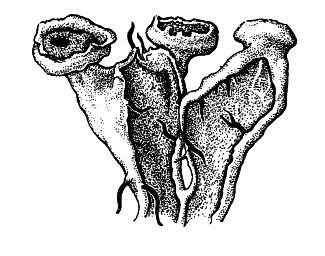Seaside centipede
Physciaceae
Introduction to the Lichens
Map
Distribution of Heterodermia sitchensis unavailable
Introduction
The seaside centipede is found in North America only in Alaska, British Columbia and Oregon, where it is occurs in wet maritime old growth coastal forests in the coastal fog zone. In British Columbia it is found in the Very Wet Hypermaritime subzone of the Coastal Western Hemlock Zone (COSEWIC 2006). It is found specifically on Sitka spruce (Picea sitchensis). In British Columbia, survey work by lichen experts Irwin Brodo and Trevor Goward, from 2000 to 2004, has expanded its known range in BC from a single location at Pacific Rim National Park to an area extending from Folger Island to the south and Kyuquot in the north (BCCDC 2010). Specific locations include Pacific Rim National Park Reserve, Quisitis Point, Ucluth Peninsula, Wouwer Island, Lawrence Islets, Folger Island, Spring Island, Mission Group Islands, and Dicebox Island (BCCDC 2010). In spite of intensive field surveys, however, the species remains rare and is limited in occurrence.
This is a foliose, erect, basally attached, cushion forming species of macrolichen that can be recognized by the "presence of marginal cilia and tiny urn-like structures near the lobe tips" (COSEWIC 2006). The upper surface is described by the BCCDC (2010) as: "Upper surface of thallus strongly convex, pale greenish white but discolouring to bluish black, often bearing scattered whitish spots (maculae)". It is a short-lived species that is found on sheltered twigs with a high nitrogen content in the lower canopy of Sitka spruce (BCCDC 2010, COSEWIC 2006). It is a pioneer species that is ultimately displaced by mosses, hepatics and other lichens (COSEWIC 2006) This species is associated with several key conditions, including nitrogen-rich twigs, seaside locations, bird perches, and sea lion wintering grounds (COSEWIC 2006). The COSEWIC status report provides insight into the sea lion association: "One of the most productive sites for H. sitchensis is located on the north shore of Wouwer Island, well known as a winter haulout for California and Steller's sea lions, which gather here in the hundreds. The sea lions occupy rock shelves, beaches, and even penetrate a short distance into the forest. To judge from the results of recent elemental analyses of Sitka spruce twigs collected from this locality (Goward & Fredeen 2006, in prep.), the resulting aerosols impregnate nearby trees, considerably elevating bark pH. Not surprisingly, such localities provide prime habitat for H. sitchensis" (COSEWIC 2006). Read the COSEWIC Status Report. |
Species Information
General:
Common Name: The Centipede Lichens. Descriptive of the elongate lobes and cilia that line the lobe margins in most species.
Small to medium stratified foliose lichens, corticate above, corticate or not below, sorediate or not, lobes loosely attached or semi-erect, elongate-linear to elongate, averaging to 0.5–2 mm wide, thin. Upper surface whitish, sometimes maculate, weakly longitudinally striate, lobe margins ciliate. Lower surface white, partly noncorticate (and then appressed-cottony), lacking rhizines or bearing sparse rhizines. Medulla white. Photobiont green.
Apothecia located over upper surface, often near lobe tips, disc brown; spores 2-celled, ellipsoid, brown, 8 per ascus.
Over trees.
Notes: Heterodermia is primarily a genus of temperate latitudes. Of the approximately 80 species worldwide, 21 are reported for North America and three for B.C.
Species description:
Lobes short or only slightly elongate; marginal cilia at most averaging to 0.5–2 mm long; soredia restricted to urn-shaped structures over upper surface or if located over lower surface, then positioned near lobe tips AND
Upper surface strongly convex; soredia lacking on lower surface, restricted to urn-shaped structures over upper surface
Comments:
The type locality is in Pacific Rim National Park, Vancouver Island, B.C.
Reactions:
Cortex K+ yellow; medulla K+ yellow, PD+ orange.
Contents:
Atranorin, zeorin and various unknown substances.
Source: Lichens of British Columbia
Illustration

If more than one illustration is available for a species (e.g., separate illustrations were provided for two subspecies) then links to the separate images will be provided below. Note that individual subspecies or varietal illustrations are not always available.
Illustration By: Trevor Goward
Habitat and Range
Habitat: Rare over spruce in open, but somewhat sheltered seaside sites in hypermaritime localitiesWorld Distribution: western N Am, known only from BC.
Source: Lichens of British Columbia
Status Information
| Origin Status | Provincial Status | BC List (Red Blue List) | COSEWIC |
|---|---|---|---|
| Native | S1 | Red | E (Apr 2006) |
BC Ministry of Environment: BC Species and Ecosystems Explorer.
Similar Species
Physcia tenella, another tree-dwelling species with pale greenish lobes lined with cilia, has soredia on the undersides of the lobe tips instead of around the apothecia, and the lower surface of the thallus cartilaginous instead of cottony. Cavernularia hultenii can also sometimes be similar, but the lower surface is black and pocked with tiny pits (COSEWIC 2006y).
Source: British Columbia Conservation Data Centre |
References
COSEWIC. 2006. COSEWIC Assessment and Update Status Report on the Seaside Centipede Lichen Heterodermia sitchensis in Canada. Committee on the Status of Endangered Wildlife in Canada, Ottawa.